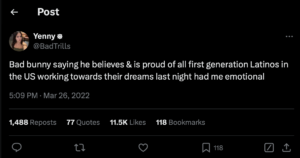A prevailing alignment with Latinidad in the United States by individuals with ties to the Latin American region points to a successful attempt at organizing its heterogeneous members under a single category in order to fulfill varying purposes. Consequently, an examination of the motives behind the decisions to carry out this alignment, as well as an understanding of the grounds on which this identification was developed, becomes necessary to understand the success of this broader categorization. In particular, the fabrication of a term to categorize individuals solely on the basis of language and geography has allowed for the development of a market that compartmentalizes diverse tastes.
Understanding Latinidad
The decision to categorize oneself as Latino may act as a consequence of the search for community, or simply of a submission to the status quo. Irrespective of one’s motivations, and even of one’s awareness that these motives exist, this umbrella term yields a generalization of tastes that belong to those that fall under it. Thus, this categorization assumes a relationship to capitalistic practices where establishments are able to perform methods of appealing to the general tastes assigned to Latinidad. Such is the case for Bad Bunny whose continuous public recognition of his Latinidad has played a significant role in his ability to amass success in the United States. Consequently, there is room to explore his selective identifications with Latinidad as a marketing tool, and the effects of this alignment on his relationship with his U.S.-Latino fanbase.
Judgments on the validity of the Latino identity have diverted from understanding this identity as a naturally-occuring categorization due to its widespreadness. The initial rejection of a panethnic identity by those set to fall under this categorization stands in stark contrast to the presence of Spotify’s “Viva Latino” playlist, for example (Mora 3). Perspectives on the development of Latinidad consider its fabrication to be a result of the government’s need to group members of a geographic region for purposes of the Census, but also as a way for “media networks… hoping to connect Mexican American, Cuban American, and Puerto Rican audiences across the country,” as well as a way of securing grant funding for the benefit of Latinos (4-5).
Parallel to numerous explanations for the historical development of Latinidad, there are just as many perspectives on whether or not this identity is justified in its existence. Negative sentiments toward this identity arise from experiences of rejection with the community associated with Latinidad as well as feelings of constraint that result from this classification (Salazar). Additional considerations of vast race diversity amongst those categorized within the Latino identity, as well as the political implications of classifying people with different priorities under one class, drive many away from accepting this term (Salazar). However, there is a simultaneous push for acceptance of Latinidad by reworking its scope to “constitute the heterogeneous experiences of various Latina/o national groups” (Aparicio 115). Despite diverging attitudes towards Latinidad, there seems to be an overarching identification with Latinidad that has ultimately aided in the prosperity of a market that generalizes and appeals to the tastes of this group (Brackett 778).
Marketing Latinidad
The development of a Latino market occurred on the basis of a shared language that pointed to “a panethnic collective” (Mora 129). The use of data to understand the consumption tastes of Latinos has, however, led to an understanding of Latinos as a “mass of undifferentiated consumers” (Davila 72). However, this has raised visibility for the strong purchasing power of Latinos and the need to create products that appeal to their consumer needs, even if such products appeal to a homogenized taste. Furthermore, the success of these homogenizing processes have become apparent through Bad Bunny’s ability to dominate the U.S. mainstream market, perhaps through his strong appeal to Latinos within this market.
Identifying with Latinidad
Bad Bunny: “I’m Latino, I’m Puerto Rican… People can feel that” (4:40-8)
Bad Bunny’s appeal to the Latino market occurs through his explicit identification with Latinidad throughout public forums. While his relationship to Puerto Rico, its culture and people has been expressed in a way that does not leave room to question its authenticity, his relationship to Latinidad retains space for exploration.
Bad Bunny’s relationship with Latinidad has found expression through mediums ranging from his song lyrics to interviews and newspaper articles. However, such expressions also display a complicated attachment to this term. While in a GQ article he may refer to perceptions of him as “this guy, who’s Latino” (Chocano), in a Rolling Stones interview, he expresses having “felt rejection in the U.S…. because of [his] being Latino” (Lopez). Alongside his self-identification with Latinidad, there is also a demonstrated understanding of the experiences of Latinos within the United States.
While Benito’s self-conception as a Latino has had explicit declarations, he also affirmed in the same GQ article that he’s “never made a song thinking… ‘This is to capture the gringo audience.’” Rather, he “makes songs as if only Puerto Ricans were going to listen to them” and “forget[s] the entire world listens to [him]” (Chocano). This can be understood to convey a lack of sustained consideration for his overall U.S. Latino audience, thus diverging from his apparent use of Puerto Rican and Latino as interchangeable terms in the above interview with Trevor Noah. This marks a difference in attitude between Bad Bunny’s authentic Puerto Rican identity and his selectivity in appealing to Latinidad.
Bad Bunny references a number of Latino identities in the Tití Me Preguntó music video: “Tengo una colombiana / Que me escribe to’ los día’ / Y una mexicana que ni yo sabía / Otra en San Antonio que me quiere todavía / Y las de PR que todita’ son mía’ / Una dominicana que es uva bombón / Uva, uva bombón / La de Barcelona que vino en avión”
Bad Bunny’s stated affinity with Latinidad, an identity developed in a U.S. context, maintains elements of authenticity. In his conversation with Noah, he expresses a belief that his Latinidad should feel obvious to those watching him. However, taken in tandem with an even stronger connection to his Puerto Ricanness and claims that his music is made for this audience only, it becomes difficult to view his connection to Latinidad as occurring on par with his relationship to Puerto Rico. Consequently, there is room to consider the presence of another element than merely an authentic connection to Latinidad, namely the use of a marketing strategy.
Bad Bunny’s “El Apagón” song and music video dedicated to bringing awareness to the ongoing issues of blackouts occurring in Puerto Rico
Benito’s origins in Puerto Rico have been placed at the forefront of his identity through his continuous declarations of love for the island through lyrical and visual references as well as advocacy for issues, all related to Puerto Rico. Centering this aspect of his identity has simultaneously developed into an important aspect of his brand identity as an artist, evidenced by his creation of a specific brand of PFKNR. Additionally, he has tied his care for the island into his music through the release of a documentary for El Apagón. Interestingly, within a song dedicated to Puerto Rico, he contends that “ahora todos quieren ser Latino.” Thus, there is still evidence of attempts to appeal to a broader Spanish-speaking audience beyond Puerto Ricans.

Branding Latinidad
Developing a brand as successfully as Bad Bunny has necessitates the crafting of an identity with the ability to attract a widespread market. This can be done by “forming strong brand narratives” which can include the “construction of ‘a recognisable look, name and style’” (Preece & Kerrigan 1210). Furthermore, the construction of a brand requires a number of actors in order to add meaning to this branding (1218). This can be applied to Bad Bunny’s appeals to Latinidad and those involved within this categorization. In developing an explicit relationship to Latinidad, Bad Bunny centers this identity in his artistic brand, thus forging a space for him to connect with U.S. Latinos. However, classifications of his appeals to Latinidad as a marketing tactic that is based on building relationships with Latinos remains unavoidable.
The video below evidences Benito’s awareness of his ability to produce shifts in the Latino market through his own creation of trends. However, his understanding of the market over the years seems to have evolved to include tactics of explicit references to Latinidad. Beyond his public identification with the Latino identity, his acknowledgment of other identities within the Latino category in “Tití Me Preguntó” act as a method of appealing to the Latino market. Furthermore, the music video’s tribute to Dominican culture in New York can act as an attestation to his attempts to connect to Latinos beyond just Puerto Ricans.
Bad Bunny on his understanding of the Latino market
Without questioning the authenticity of Bad Bunny’s identification with the Latino identity, his awareness of the success of developing a public relationship to its people is also indisputable. Through his explicit identification and appreciation of this identity, Bad Bunny has managed to form a relationship with U.S. Latinos. Consequently, this has allowed him to amass an unprecedented success largely due to the reciprocated affinity for Bad Bunny expressed by U.S. Latinos. While Bad Bunny continuously makes appeals to Latinidad, whether to purposefully find market success or because of an authentic desire to find community in the U.S., Latinos are able to find haven in an artist that demonstrates continuous appreciation for their identity. Still, the relationship produced between artist and identity creates room for both an appreciation for and an exploration of the numerous techniques and degrees of authenticity involved.
Works Cited
“Bad Bunny on Breaking the Mold in the Latino Market.” Youtube, REMEZCLA, https://youtu.be/DbUdZYRgpaU?si=LzsUag2H4mBfNvA0.
“Bad Bunny – Staying True to His Culture & Identity.” The Daily Show, YouTube, https://youtu.be/8ilaxXnPKkM?si=0OgEepvNXmQkuKp.
Chocano, Carina . “The World’s Newest Superhero: Bad Bunny.” GQ, 24 May 2022, www.gq.com/story/bad-bunny-june-cover-profile.
Brackett, David. “The Politics and Practice of ‘Crossover’ in American Popular Music, 1963 to 1965.” The Musical Quarterly, vol. 78, no. 4, 1994, pp. 774–97. JSTOR, http://www.jstor.org/stable/742509.
- Cristina Mora. Making Hispanics : How Activists, Bureaucrats, and Media Constructed a New American. University of Chicago Press, 2014. EBSCOhost, search.ebscohost.com/login.aspx?direct=true&db=nlebk&AN=2403429&site=ehost-live.
Lopez, Julyssa. “Bad Bunny Conquered the World. Now What?” Rolling Stone, Rolling Stone, 29 Oct. 2024, www.rollingstone.com/music/music-features/bad-bunny-coachella-el-apagon-controversy-future-interview-1234770225/.
Lopez Mari, Kacho, Director. El Apagón – Aquí Vive Gente. Journalism by Bianca Graulau, YouTube, https://youtu.be/1TCX_Aqzoo4?si=89ESMGe06HWuoiJK.
Preece, C., & Kerrigan, F. (2015). Multi-stakeholder brand narratives: an analysis of the construction of artistic brands. Journal of Marketing Management, 31(11–12), 1207–1230. https://doi-org.ezproxy.princeton.edu/10.1080/0267257X.2014.997272
Salazar, Miguel. “The Problem with Latinidad.” The Nation, 16 Sept. 2019, www.thenation.com/article/archive/hispanic-heritage-month-latinidad/.
Stillz, Director. Tití Me Preguntó. YouTube, 2022, https://youtu.be/Cr8K88UcO0s?si=S3UBvao1oZCSLO9O.
“31. Latinidad/es: Frances r. aparicio”. Keywords for Latina/o Studies, edited by Deborah R. Vargas, Lawrence La Fountain-Stokes and Nancy Raquel Mirabal, New York, USA: New York University Press, 2017, pp. 113-117.
